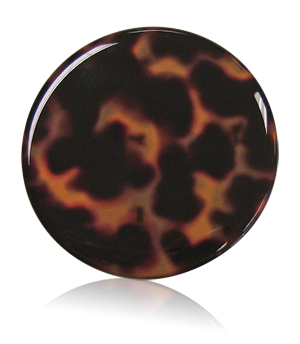Tortoise shell has been prized for ornamental purposes since early times. It was one of the treasures of the Far East that was brought through Egypt to Rome, where it was used extensively to veneer beds and cabinets. Ornamental tortoise shell does not come from a land tortoise, as sometimes supposed, but from the hawksbill turtle, the smallest of the marine turtles. The upper shell, or carapace, consists of three rows of beautifully mottled plates, dark brown on a yellowish base, that overlap like shingles. The center row consists of five plates, and the row on either side has four plates each. "Yellow belly" which is a trade name for the under shell, or plastron, is valuable for its attractive yellow plates. These plates, which are shaped like a V, usually number twenty-four and are known as "hoofs". Tortoise shell plates are similar to ordinary horn in composition, being entirely devoid of mineral matter; however, they are appreciably harder, less fibrous and more brittle than horn. In the adult turtle, they measure about eight by thirteen inches and weigh approximately nine ounces each. The weight of the hawksbill turtle varies from one hundred to two hundred pounds.
The hawksbill, which is principally an inhabitant of tropical or semitropical seas, is caught by harpooning. It lives in shallow lagoons at 50 to 60 foot depths and thrives on fish and other small sea life for food. It is migratory and lives in the Indian and Pacific Oceans and the Caribbean sea. The bulk of the shell today is shipped from the West Indies, south and central America and the eastern archipelago, particularly from the east cost of the Celebes to New Guinea. Most of it is sent to Shanghai and Singapore for exportation to Japan for processing. shell from Info-pacific area is generally considered to be most desirable; it is more transparent and the mottled brown and yellowish coloration has a richer appearance. shell from the other regions mentioned varies from mottled brown to yellowish, black and white or greenish.
Tortoise shell is easily workable by heating (thermoplastic) and can therefore be fashioned into many different kinds of articles. Heating causes the release of a superficial film that becomes firmly sealed. The process of preparing the rough plates, which are often covered with barnacles, follows this sequence; scraping; buffing with a felt wheel impregnated with tripoli powder; final polishing heating and cutting and forming (bending) into the final articles. Among the many uses of tortoise shell are guitar picks, combs, violin frogs, shoe buckles, cigarette holders, cufflinks, knife handles, hair-brush handles, mirror backs, trinket boxes and inlay material for clocks and similar articles. An assembled product is made of a thin veneer of the shell cemented to a suitable plastic. Foreign made articles are somewhat crude and usually poorly polished with dry crumbled leaves of a local trees. Although occasionally such small objects appear on the market, the majority are subjected to a final buffing and polishing in the country before being placed on sale.
Because the manufacturing of tortoise shell items falls into the same artistic category as ivory, it leaves little room for favorable comment on plastic imitations, except possibly a price difference. Many hours are often spent in making a single article from the genuine material, and its fine texture permits a smoother and tougher finished product. Because of this, a fine dressing comb or pocket comb does not tear or damage the hair follicles; moreover, unlike other materials, it eliminates the static electricity that is so commonly encountered in many substitutes.
The value of tortoise shell is affected by its supply and quality.
The supply is limited for the following reasons:
- The average yearly catch from all Sources is approximately 750 turtles;
- the turtles are found only in tropical and semitropical seas;
- the raw material used for jewelry purposes is obtained from only one species, the hawksbill;
- the animal is hunted for its eggs as well as for its shell and
- imitations resembling the genuine product are cheaper and easier to produce.
Various aspects of quality also affect value materially:
- Degree of transparency, the warmth of the pleasing background, the thickness of the mottled brown coloring, and the high degree of polish the material can receive and retain;
- the thickness of the plates;
- if the turtle dies a natural death, decomposition causes the shell to assume a cloudy or milky effect, thus lowering value:
- the thin yellow plates on the under shell of an old turtle are highly prized
- shells that have a white background with black spots are rare and desirable;
- the best-quality shell is usually taken from the carapace;
- shell may shrink with age, a condition that is noticeable in old pieces or inlay work.
Tortoise shell is amorphous (and therefore isotropic), has an oily to waxy luster, a hardness of 2 1/2, a fair degree of toughness (it is brittle and sectile), no cleavage, an uneven and dull fracture, an S.G. of 1.29, and an R.I. of 1.55. It is attacked by nitric acid but is unaffected by hydrochloric acid. High heat tends to darken the material if it is burned in an open flame; therefore, it must be worked at low temperatures. The odor when burning is distinctly that of burning hair, It softens at the temperature of boiling water. Thin sections observed under the microscope reveal an unmistakable characteristic mottling containing numerous spherical particles, stained horn and various plastic imitations do not show this. In addition, it is well known that the textural richness and brilliance of polish of fine tortoise shell cannot be approached by plastics.


